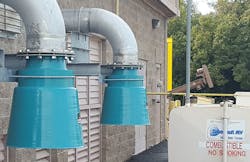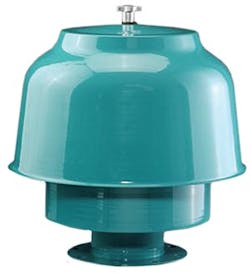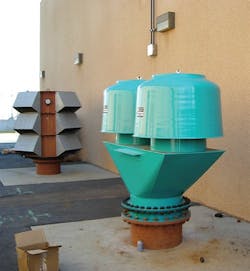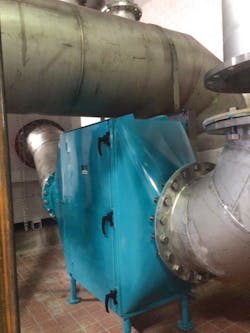The promise of reducing burdensome energy costs for process air equipment encouraged owners to update blowers, fans and compressors with new technologies that boast higher efficiencies. After transitioning, however, many end users discovered that state-of-the-art process technologies required intake filtration designed for the 21st century. These improved intake filters and intake filter silencers reduced inlet losses and extended maintenance intervals so the design engineer or end user could enjoy the full promise of the new process equipment without compromising process reliability.
Early intake filter options
In the 1980s, energy costs for process equipment were an afterthought. Reliable equipment was the important factor when deciding which technology to install. In the wastewater industry, multistage and positive-displacement blowers were the technology of choice. At the time, only two options were available for intake filtration – panel filters and cartridge filters.
An example of an intake filter silencer
Because power consumption was not a priority, neither method was designed to reduce inlet restrictions. Panel filters required large, heavy housings; were inefficient; and were susceptible to bypass because of the inability to mechanically seal the panel element in the filter housing. The air flow through these housings created pressure losses that negatively affected power consumption, and the bypass of dirty air was transmitted to the process. To improve on this bypass problem, cartridge filters were developed.
The cylindrical shape of the cartridge increased the useful surface area and added a gasket on the sealing end. Using bolts or hand knobs on the opposite side of the gasket created compression once tightened, which reduced bypass. Because of the sealing ability of the cartridge filter, this method became the standard for filtration, even though this design did little to improve power consumption.
Gearless HST
At the start of the 21st century, plant owners, engineers and blower manufacturers became more aware of the actual costs required to operate traditional blowers. As a result, a new technology was developed – the gearless high-speed turbo (HST) blower. The HST used high-speed and frictionless bearings, either air or magnetic, and promised to be the solution to reduce power consumption, noise, and installation and maintenance costs. These compact plug-and-play machines became an instant success because of their energy savings when compared to traditional blowers, but the promise of reduced maintenance was not being realized by all who adopted this technology.
One issue was many of these 21st-century machines used panel filter elements more suitable for HVAC systems. This required the operators of the HST blower to keep their blower rooms clean, change filters often and vacuum the blowers’ enclosures – which made the maintenance requirements more frequent and involved than with the previous equipment.
At about the same time as the development of the HST, the Tri-Vent® Intake Filter Silencer from Endustra Filter Manufacturers Inc. debuted for the traditional blower market. The goal of this intake filter silencer was to deliver zero-bypass clean air to process equipment while reducing power consumption.
Intake filter silencer installed next to an older style pane filter
The intake filter silencer was designed by applying basic aerodynamic principles to contour air flows through the filter and into the blower. The design, which also incorporated conical cartridge filter elements with proprietary self-supporting synthetic filter media for increased capture efficiencies, reduced initial losses typically seen in traditional cartridge filter housings by 30 to 50 percent. By focusing on reducing the initial restrictions of the intake filter, which in turn reduced the differential pressure required across the blower, the end user gained energy savings and increased the filter element service life by two to three times more than traditional filter designs.
The intake filter silencer, which eliminates bypass, adds efficiency and is designed to extend service intervals, makes possible the HST’s low-maintenance promise, and further reduces power consumption by lowering initial restrictions. Because the improved filter design offers zero bypass, it eliminates dust buildup on the blower’s impeller, helping maintain the technology’s original efficiencies. With a properly designed intake filter silencer, monthly filter element change intervals can be stretched to biannual or annual requirements, further reducing maintenance and its associated costs while better protecting HSTs and process air quality.
Intake filter silencer installed before a HST blower
Conclusion
The intake filter silencer is energy efficient and extends maintenance intervals. Because of this, it can complement and increase the proven energy efficiencies of HST blowers and help them keep their promise of reduced maintenance.
The energy savings to be gained with 21st century filtration are significant. An initial restriction reduction of 2 inches of water column (WC) on a 300-horsepower, 6,000-standard-cubic-feet-per-minute (SCFM), 8.5-psig HST blower (operating at standard temperature and conditions) can yield a power savings of 4 kilowatts (kW). A 4-kW savings will reduce a power bill by $3,500 per year. This savings will pay for the intake filter silencer in less than two years (see Table 1).
Table 1. Details of a blower operating at standard conditions — 68ºF, 36 percent relative humidity, 14.7 psia — with a required discharge pressure of 8.5 psig compared to an HST with a misapplied HVAC filter. The power savings based on 24/7 operation at $0.10 per kW are more than $3,500.
Patrick Gedgaudas has spent 17 years introducing new technologies to the compressed air and blower markets throughout the U.S. Today he works as a market strategist for Indiana-based Endustra Filter Manufacturers Inc., the original designer and patent holder for the Tri-Vent Series Intake Filter and Filter Silencer. Gedgaudas may be reached at [email protected] or 800-521-1008.
Endustra Filter Manufacturers Inc.





